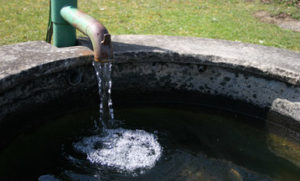It is highly recommended to do a comprehensive well water analysis at time of inspection.
NewEnglandRadon.com
Radon and Well Analysis
ArsenicChloride
Copper
Fluoride
Iron
Lead
Manganese
Nitrate / Nitrite
pH
Sodium
Total coliform
Arsenic

The U.S. Environmental Protection Agency (EPA) has set the health standard at 0.010mg/L. Some of the health effects are skin irritation, skin cancer, liver and kidney damage and damage to the central nervous system. Its origin in New Hampshire drinking water is not fully known, but could come from the bedrock in the state, or of man-made sources such as metal refining processes or pesticides.
Chloride
Though chloride is not considered a health hazard, the standard has been set at the level at which the average person notices a salty taste. Chloride is associated with infiltration of road de-icing salt, backwash from a water softener and sea water.
Copper
The high copper concentrations in New Hampshire are almost always a result of corrosive water picking up copper from plumbing lines. The acceptable limit is set at 1.0 mg/L. Water above the limit may have an unpleasant taste and cause blue or green staining on water use fixtures.
Fluoride
Fluoride is widely used to prevent tooth decay, but in excess it can cause spotted or pitted teeth, called fluorosis. Recommended adult intake of fluoride is 1.0-2.5 mg per day. Children are often given a supplement if the fluoride level in their home drinking water is not sufficient HardnessSMCL = 250 mg/L
The contributors to hardness are calcium and magnesium. The presence of these elements in general is not a health hazard, but hardness elements tend to plate out on water pipes and heating coils in hot water tanks, and reduce the effectiveness of detergents.
Water treatment companies often express hardness in grains per gallon (gpg). 1 gpg equals 17.1 mg/L
Iron
Over 0.30 mg/L, iron becomes a nuisance element. It will show its presence as rust stains on water fixtures and if chlorine bleach is used in the laundry, rust spots will appear on clothes. If this happens, use a non-chlorine bleach with your clothes. Common iron removal methods include ion exchange and oxidation filtration.
Lead
Chronic ingestion of lead has been associated with a large number of harmful health effects, and therefore water with excessive lead levels should not be consumed. High levels can be attributed to old lead piping, lead solder used on copper piping and some installed pumps. In most cases, lead in your drinking water can be reduced by running the water before filling a glass to drink. pH, alkalinity and hardness correction will reduce corrosion damage.
Manganese
Over 0.05 mg/L manganese becomes a nuisance element and its presence is detected by purplish black staining of kitchen and bathroom fixtures. The 0.05 mg/L SMCL is the threshold for staining by most humans. Above this level your drinking water would have an oily vinyl or metallic taste. A “rotten egg” smell, due to the presence of hydrogen sulfide is often associated with a high iron and manganese level, which tends to disappear when the iron and manganese are removed. Manganese is also an essential nutrient for humans at approximately 5 mg per day.
Nitrate / Nitrite
The presence of nitrate and nitrite generally indicates contamination from a pasture, manure pile, decomposed vegetation or fertilized agricultural land. Nitrates change to nitrites in the body, which reduces oxygen uptake by the hemoglobin. Boiling water will not help, it will only concentrate the nitrates.
pH
Recommended 6.5 – 8.5pH is a measure of acidity of a sample. The scale is 0-14. A reading to 0-7 is acidic, 7-14 is basic (or alkaline), and 7 is neutral. Acidic water, along with low hardness (soft water), tends to be corrosive to your water pipes, potentially dissolving lead and copper. Basic water itself is not a problem, but may have a bitter taste. Alkalinity, which is a separate measurement, is your water’s capacity against drastic pH changes.
Sodium
Some sodium is found in all natural water supplies, but more so in areas where sea water and road salt seep into the ground. Sodium has no set health hazard level, but those individuals on a low sodium diet should take into account the amount of sodium in their water when determining overall sodium intake.
Total coliform
Total coliform are a group of bacteria with common characteristics used to indicate unacceptable drinking water quality. Within the total coliform group, the E. Coli bacteria are specifically used to indicate fecal contamination. High non-coliform levels are usually from the drilling of the well or an indication of surface water intrusion. When non-coliform are greater than 200 CTS per 100ml they can obscure the growth of coliform.
If the total coliform, especially E. Coli and/or high non-coliform counts are present in a well, it needs to be checked for construction problems. It is very common for new or modified wells to have unacceptable bacteria levels, and often it is necessary to disinfect with bleach or chlorine tablets more than once. If you have a positive total coliform, E. Coli or high non-coliform count, you should have received an Unacceptable Bacteria Notification which includes disinfecting instructions.
